European Championship Stadiums & Stats
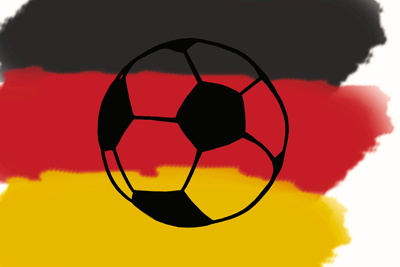 The European Championships began in 1958 as a competition between 17 members of UEFA. The initial tournament took place over 22 months with 17 teams whittled down to a final four who then competed in a knockout for the trophy in France in 1960. The European Championships was actually a late comer compared to other continental championships but over the years has risen to perhaps the biggest national football championship outside of the World Cup.
The European Championships began in 1958 as a competition between 17 members of UEFA. The initial tournament took place over 22 months with 17 teams whittled down to a final four who then competed in a knockout for the trophy in France in 1960. The European Championships was actually a late comer compared to other continental championships but over the years has risen to perhaps the biggest national football championship outside of the World Cup.
The first European crown was won by the then Soviet Union who beat Yugoslavia 2-1 at Paris Saint Germain’s Parc de Princes in 1960 in front of 18,000 people. Euro 2024 represents the 17th incarnation of the tournament that has been won by 10 different nations. The 2021 finals were the first to be held with no fixed host, with matches played across the continent but for 2024 the Euros reverts to a single host, Germany. West Germany hosted in 1988 but this will be the first time Germany has hosted as a unified country. In fact, Leipzig will host some matches and these will be the first European Championship games held in former East Germany.
On this page you will find full guides and statistics about all Euro 2024 stadiums that are due to be used in the next tournament. We’ll also have full fixture listings for all finals matches, history, format, statistics and more. Click any stadium to see the full stadium page see below the table for summaries of all the stadiums.
In 2028 the Euros will held across England, Northern Ireland, Scotland, Wales and Republic of Ireland, with the host announced in late 2023. It will be the third time that England has hosted or co-hosted the Championships, second time for Scotland and the first time for the other home nations and Ireland.
European Championship Stadiums
| Stadium | Year Opened | Capacity | Ave Attendance | Record Attendance | Record Attendance Match |
|---|---|---|---|---|---|
|
Allianz Arena
Bayern Munich |
2005 | 75000 | 71000 | 75000 | B Munich v Schalke 04 (2015) |
|
Deutsche Bank Park
Eintracht Frankfurt e.V. |
1925 | 51500 | 26338 | 81000 | Eintracht Frankfurt v FK Pirmasens (1959) |
|
Mercedes-Benz Arena (Stuttgart)
VfB Stuttgart |
1933 | 60441 | 28908 | 97553 | Germany-Switzerland (22nd November 1950) |
|
Merkur Spiel-Arena
Fortuna Düsseldorf |
2004 | 54600 | 44339 | Unknown | |
|
Olympiastadion Berlin
Hertha Berlin |
1936 | 74475 | 50267 | 88075 | Hertha Berlin v 1 FC Köln (1969) |
|
Red Bull Arena (Leipzig)
RB Leipzig |
2004 | 47069 | 41385 | 43348 | RB Leipzig v VfL Wolfsburg (2015) |
|
RheinEnergieStadion
FC Cologne |
1923 | 50000 | 49571 | 76000 | Germany v Austria (1953) |
|
Signal Iduna Park
Borussia Dortmund |
1974 | 81365 | 80520 | 83000 | Dortmund v Schalke 2004 |
|
Veltins-Arena
FC Schalke 04 |
2001 | 62271 | 61386 | 77803 | Germany v United States Ice Hockey 2010 |
|
Volksparkstadion
Hamburg SV |
2000 | 57000 | 53700 | 57000 | Hamburg v Bayern Munich (2009) |
Group Stages
Group A
| Fixture | Date & Time | City | Stadium | ||
|---|---|---|---|---|---|
 Germany Germany | v |  Scotland Scotland | Fri 14th June | Munich | Allianz Arena |
 Hungary Hungary | v |  Switzerland Switzerland | Sat 15th June | Cologne | RheinEnergieStadion |
 Germany Germany | v |  Hungary Hungary | Weds 19th June | Stuttgart | Mercedes-Benz Arena |
 Scotland Scotland | v |  Switzerland Switzerland | Weds 19th June | Cologne | RheinEnergieStadion |
 Switzerland Switzerland | v |  Germany Germany | Sun 23rd June | Frankfurt | Deutsche Bank Park |
 Scotland Scotland | v |  Hungary Hungary | Sun 23rd June | Stuttgart | Mercedes-Benz Arena |
Group B
| Fixture | Date & Time | City | Stadium | ||
|---|---|---|---|---|---|
 Spain Spain | v |  Croatia Croatia | Sat 15th June | Berlin | Olympiastadion |
 Italy Italy | v |  Albania Albania | Sat 15th June | Dortmund | Signal Iduna Park |
 Croatia Croatia | v |  Albania Albania | Weds 19th June | Hamburg | Volksparkstadion |
 Spain Spain | v |  Italy Italy | Thurs 20th June | Gelsenkirchen | Veltins-Arena |
 Albania Albania | v |  Spain Spain | Mon 24th June | Düsseldorf | Merkur Spiel-Arena |
 Croatia Croatia | v |  Italy Italy | Mon 24th June | Leipzig | Red Bull Arena |
Group C
| Fixture | Date & Time | City | Stadium | ||
|---|---|---|---|---|---|
 Slovenia Slovenia | v |  Denmark Denmark | Sun 16th June | Stuttgart | Mercedes-Benz Arena |
 Serbia Serbia | v |  England England | Sun 16th June | Gelsenkirchen | Veltins-Arena |
 Slovenia Slovenia | v |  Serbia Serbia | Thurs 20th June | Munich | Allianz Arena |
 Denmark Denmark | v |  England England | Thurs 20th June | Frankfurt | Deutsche Bank Park |
 England England | v |  Slovenia Slovenia | Tues 25th June | Cologne | RheinEnergieStadion |
 Denmark Denmark | v |  Serbia Serbia | Tues 25th June | Munich | Allianz Arena |
Group D
| Fixture | Date & Time | City | Stadium | ||
|---|---|---|---|---|---|
 ? ? | v |  Netherlands Netherlands | Sun 16th June | Hamburg | Volksparkstadion |
 Austria Austria | v |  France France | Mon 17th June | Düsseldorf | Merkur Spiel-Arena |
 ? ? | v |  Austria Austria | Fri 21st June | Berlin | Olympiastadion |
 Netherlands Netherlands | v |  France France | Fri 21st June | Leipzig | Red Bull Arena |
 Netherlands Netherlands | v |  Austria Austria | Tues 25th June | Berlin | Olympiastadion |
 France France | v |  ? ? | Tues 25th June | Dortmund | Signal Iduna Park |
Group E
| Fixture | Date & Time | City | Stadium | ||
|---|---|---|---|---|---|
 Romania Romania | v |  ? ? | Mon 17th June | Munich | Allianz Arena |
 Belgium Belgium | v |  Slovakia Slovakia | Mon 17th June | Frankfurt | Deutsche Bank Park |
 Slovakia Slovakia | v |  ? ? | Fri 21st June | Düsseldorf | Merkur Spiel-Arena |
 Belgium Belgium | v |  Romania Romania | Sat 22nd June | Cologne | RheinEnergieStadion |
 Slovakia Slovakia | v |  Romania Romania | Weds 26th June | Frankfurt | Deutsche Bank Park |
 ? ? | v |  Belgium Belgium | Weds 26th June | Stuttgart | Mercedes-Benz Arena |
Group F
| Fixture | Date & Time | City | Stadium | ||
|---|---|---|---|---|---|
 Turkey Turkey | v |  ? ? | Tues 18th June | Dortmund | Signal Iduna Park |
 Portugal Portugal | v |  Czech Rep Czech Rep | Tues 18th June | Leipzig | Red Bull Arena |
 ? ? | v |  Czech Rep Czech Rep | Sat 22nd June | Hamburg | Volksparkstadion |
 Turkey Turkey | v |  Portugal Portugal | Sat 22nd June | Dortmund | Signal Iduna Park |
 ? ? | v |  Portugal Portugal | Weds 26th June | Gelsenkirchen | Veltins-Arena |
 Czech Rep Czech Rep | v |  Turkey Turkey | Weds 26th June | Hamburg | Volksparkstadion |
Future Rounds
Round of 16
| Fixture | Date & Time | City | Stadium | ||
|---|---|---|---|---|---|
 ? ? | v |  ? ? | Sat 29th June | Dortmund | Signal Iduna Park |
 ? ? | v |  ? ? | Sat 29th June | Berlin | Olympiastadion |
 ? ? | v |  ? ? | Sun 30th June | Cologne | RheinEnergieStadion |
 ? ? | v |  ? ? | Sun 30th June | Gelsenkirchen | Veltins-Arena |
 ? ? | v |  ? ? | Mon 1st July | Frankfurt | Deutsche Bank Park |
 ? ? | v |  ? ? | Mon 1st July | Düsseldorf | Merkur Spiel-Arena |
 ? ? | v |  ? ? | Tues 2nd July | Munich | Allianz Arena |
 ? ? | v |  ? ? | Tues 2nd July | Leipzig | Red Bull Arena |
Quarter Finals
| Fixture | Date & Time | City | Stadium | ||
|---|---|---|---|---|---|
 ? ? | v |  ? ? | Fri 5th July | Stuttgart | Mercedes-Benz Arena |
 ? ? | v |  ? ? | Fri 5th July | Hamburg | Volksparkstadion |
 ? ? | v |  ? ? | Sat 6th July | Berlin | Olympiastadion |
 ? ? | v |  ? ? | Sat 6th July | Düsseldorf | Merkur Spiel-Arena |
Semi Finals
| Fixture | Date & Time | City | Stadium | ||
|---|---|---|---|---|---|
 ? ? | v |  ? ? | Tues 9th July | Munich | Allianz Arena |
 ? ? | v |  ? ? | Weds 10th July | Dortmund | Signal Iduna Park |
Euro 2024 Final - Sunday 14th July 20:00
| Fixture | Date & Time | City | Stadium | ||
|---|---|---|---|---|---|
 ? ? | v |  ? ? | Sun 14th July | Berlin | Olympiastadion |
Euro 2024 Stadiums
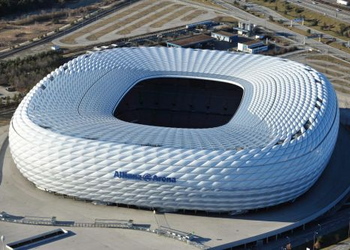
That wasn’t the only reason, of course, with the country’s lack of a decent transport infrastructure and limited hotel capacity within host cities being pointed out by UEFA’s report. Yet there’s also little question that UEFA will have been keen to avoid any conversations about the human rights issue after such controversy was stirred up when Qatar won the vote to become a World Cup host. Not that the Turkish newspapers took the decision lightly, suggesting that UEFA had ‘given its support to racism’, which was a reference to the accusations of racism within the German national side levelled by the Turkish-born midfielder Mesut Özil. The decision has been made, however, so what can we tell you about the stadiums that are the most likely to be used for the tournament when it rolls around in 2024?
Stadium Details
Having seen FIFA need to invest millions in order to allow football to be played in a country like Qatar, where temperatures can reach up to forty-five degrees Celsius, it’s perhaps somewhat unsurprising that UEFA have chosen a host nation that already has a decent footballing infrastructure. Whole cities needed to be built to make Qatar a viable place to watch the World Cup, let alone the stadia where the tournament’s matches will actually take place. The same is obviously not true of Germany, where the Bundesliga is one of the most attended football leagues in the world and countless top-quality venues are already in existence.
Again, that’s part of the reason why UEFA went with Germany over Turkey when they were making their selection of the country best placed to host the Euros in 2024. The German football association see it as an opportunity to further the sport in general in the country, with the President of the DfB, Reinhard Grindel, citing what a difference it will make ‘for grassroots football [and] for our 25,000 or so amateur teams’. Not that all of the other European countries were overly impressed with the decision, given that Germany hosted the World Cup in 1974 and 2006 as well as the Euros in West Germany in 1988, while England has still only been the national host for one World Cup back in 1966.
Even so, it is undoubtedly the brilliant facilities available in Germany that helped to sway the voting panel. Eighteen cities put themselves forward to host matches, with that number being whittled down to fifteen by the time the deadline to do so arrived in April of 2016. Only two cities, Freiburg im Breisgau and Karlsruhe, suggested needing to build new stadia in order to be considered for the bid, which shows the strength of German football. In the end, the bid team reduced the candidate venues down to the ten required, none of which were located in Freiburg im Breisgau or Karlsruhe. The German bid had the motto, “United by Football – Vereint im Herzen Europas”, which translates as ‘United by Football – United in the Heart of Europe’ and tells you everything you need to know about the stadiums selected and the bid itself.
OLYMPIASTADION – Berlin
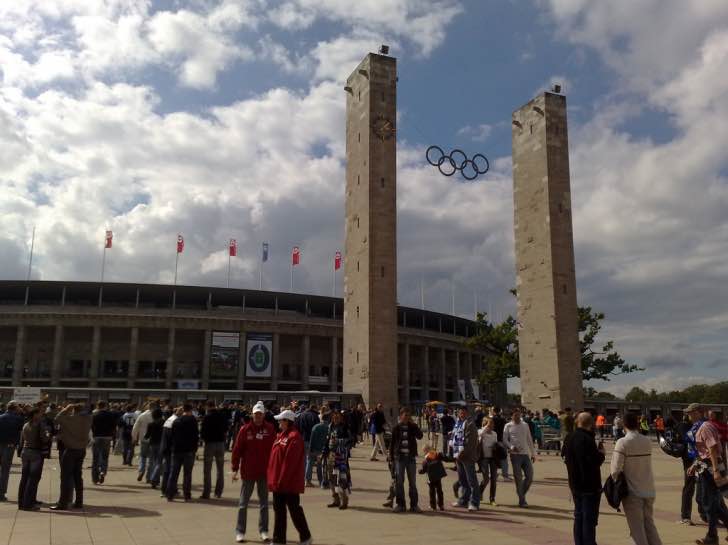
74,475
The name of the main stadium in Berlin tells you everything you need to know about it, with the venue having been constructed to host the Olympic Games back in 1936. Now part of Berlin’s Olympiapark, the stadium underwent significant renovations in 2004 ahead of being one of the host venues for the 2006 World Cup. Whilst it was initially intended to be used as an athletics venue, it has known about the trials and tribulations of hosting football matches on a regular basis since Hertha BSC began to call it home in 1963. A Category Four venue, the Olympic Stadium has hosted numerous high profile games over the years. As well as three matches during the World Cup in 1974 and six games including the final during the same competition in 2006, it was also the location for the Champions League final in 2015.
The FIFA Women’s World Cup used the Olympiastadion in 2011 and the German Cup final takes place at the ground every year, so there’s no question of the stadium struggling to cope with the influx of crowds expected in 2024. The stadium is rarely sold out for Hertha’s home games and the club is hugely accommodating, so if you want to get a taste of what to expect before the World Cup itself then it might be worth getting along to watch Die Alte Dame ply their trade in the domestic tournaments at some point. When the stadium was renovated ahead of the 2006 World Cup the entire lower tier was rebuilt, aiming to give it a more intimate feel. That there’s still a running track and it is a multi-purpose venue means that this wasn’t exactly mission accomplished, but it’s still a spectacular location to watch big games.
ALLIANZ ARENA – Munich
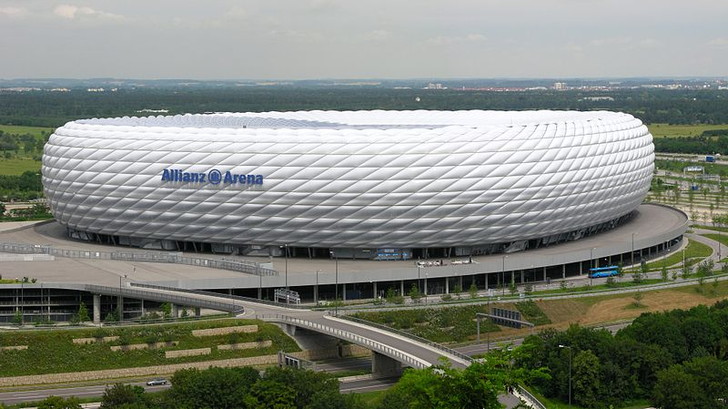
€340 million
Despite the fact that the Allianz Arena will be nearly twenty years old by the time the European Championships get underway in 2024, it is still seen as an excellent example of what a modern football stadium can look like. It boasts an exterior that is made of inflated ETFE plastic panels that can change colour, meaning that it’s the ideal venue for a competition that will have different teams playing in it every few days. That might have earned it the nickname of ‘Schlauchboot’, or ‘inflatable boat’, but it’s also made it popular with football fans from Germany and beyond. The home of Bayern Munich and sometimes the German national side, the Allianz Arena also hosted 1860 Munich from its opening in 2005 until 2017.
One of the big things to watch our for is the official name that the venue is given during the Euros. UEFA’s rules on sponsorship match those of FIFA; namely that only official partners are allowed to have their brands mentioned during the competition. As a result, the Allianz became the FIFA WM-Stadion München during the 2006 World Cup and the Fußball Arena München during Nations League games. In terms of the transport links that UEFA criticised Turkey for, the Allianz Arena offers the largest parking structure in Europe as well as the Fröttmaning U-Bahn U-Bahn station right next door to it. It truly is a wonderful venue in which to see football being played, though that is only true after FC Bayern Munich club members informed the German side that there was a draft inside that made it uncomfortable to watch matches there, leading to them installing closable doors.
WESTFALENSTADION (Signal Iduna Park) – Dortmund
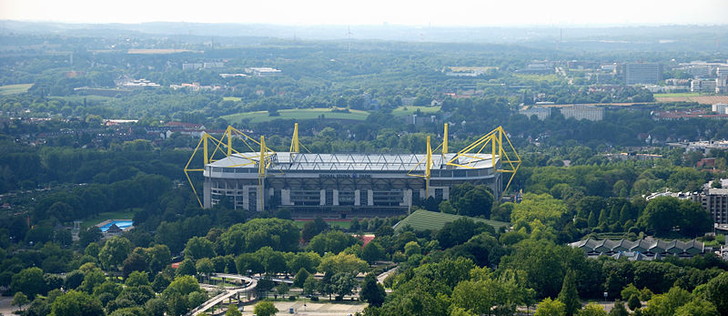
€200 million
Despite the fact that there are hundreds of thousands of football stadiums around the world, few can claim to be truly iconic. Anfield, Wembley and Old Trafford perhaps tick the box in the UK, with the latter two because of their size and the former because of the world-famous Kop. The Westfalenstadion in Dortmund finds itself on the list for both reasons, having the ability to welcome more than eighty thousand supporters due to the Südtribüne. That is the largest area for football supporters to stand in Europe, with just shy of twenty-five people able to stand on it. Sadly they don’t get to do so during UEFA matches, with the ground’s capacity reduced to just in excess of sixty-five thousand in Champions League games because of the governing body’s rules on standing. It has been used as a venue for countless big tournaments including all of Germany’s World Cup hosting duties as we as the 2001 UEFA Cup final.
The home of Borussia Dortmund is officially known as Signal Iduna Park because of sponsorship, resulting in it being known by numerous other names over the years because of UEFA and FIFA’s rules on sponsorship mentioned when discussing the Allianz Arena. In 2006 it became the FIFA World Cup Stadium Dortmund, whilst during Champions League games it is referred to as BVB Stadion Dortmund. When the Südtribüne is in full flow during Dortmund home matches it is given the nickname ‘the yellow wall’, such is the extent to which you can barely see anything except flags and tops in the club colours. Quite what UEFA will decide to do regarding which nation gets to locate its fans in there during the Euros remains to be seen, but they’ll find themselves in one of the most iconic stands in football.
ARENA AUFSCHALKE (VELTINS-ARENA) – Gelsenkirchen
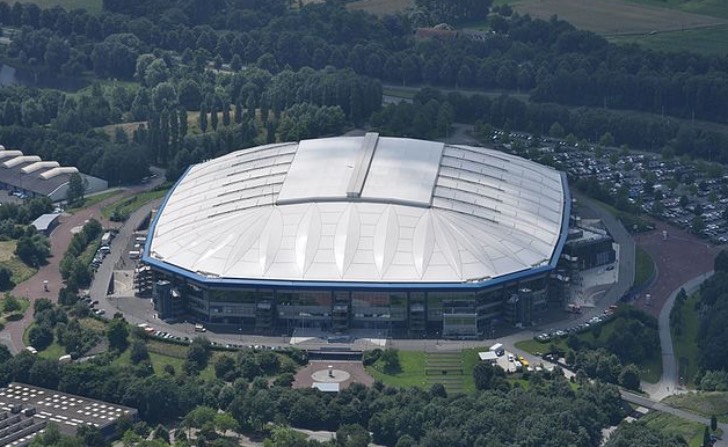
62,271 / 54,740
€191 million
FC Schalke 04
Known as Veltins-Arena because of sponsorship, the venue boasted the more unexciting name of Arena AufSchalke during its first four years of existence. That’s also the name that it returns to when it’s used to host any matches other than the domestic games of of its resident club, FC Schalke 04. Example matches when that’s been the case include the 2004 Champions League final and five games during the 2006 World Cup, including the quarter-final matchup between England and Portugal. As with the Westfalenstadion, the ground has two different capacities depending on whether or not the supporters within the venue are allowed to stand during the matches that they’re watching.
The stadium boasts two noteworthy achievements in engineering, namely the ability to retract both the roof and the pitch itself. The centre of the Teflon-coated roof can be opened or closed depending on the weather conditions on the day a football match is being played. That is impressive enough though not all that uncommon at sports arenas nowadays, yet the ability to remove the pitch in its entirety is something that only a couple of venues around the world can also do. It means that the pitch can be grown and nurtured in natural conditions without the constricts of the football stadium around it, to say nothing of the venue being able to host concerts and the like without it damaging the turf.
MERCEDES-BENZ ARENA – Stuttgart
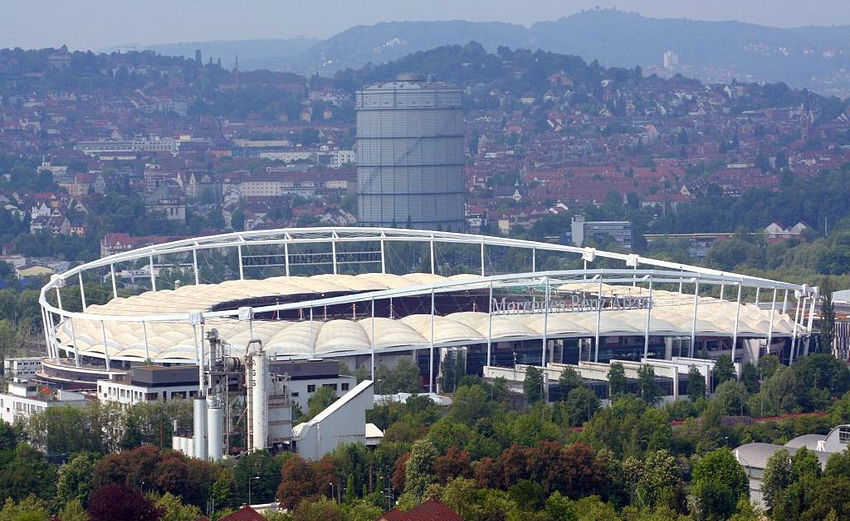
€126.7 million
As you might be realising by now, German football teams are keen on making sponsorship deals for their stadiums in order to reduce the cost of building and operating them. The Mercedes-Benz Arena in Stuttgart opened its doors for the first time in 1933 and has been renovated on numerous occasions since then. Prior to 1993 it was predominantly known as the Neckarstadion, though it has had some less savoury names during its existence. Between its opening and the end of the Second World War, for example, it held the moniker of the Adolf-Hitler-Kampfbahn. Neckarstadion came into use in 1949 and you shouldn’t be overly surprised if it’s also what it’s known as during the Euros, given UEFA’s refusal to allow companies that aren’t one of their official sponsors to have their names plastered around for free during one of their tournaments.
As well as being the home of the German side VfB Stuttgart, the German national side also play games in the venue from time to time. As well as hosting four matches during the World Cup in 1974 and six games during the same competition when it took place in Germany in 2006, the Mercedes-Benz Arena was the location for two games when the European Championships were last hosted on German soil in 1988. They were a first round game and a semi-final, plus it has hosted two European Cup finals, so the city is well versed in having to cope with an influx of large numbers of football fans. Since 2009 the ground has been specifically used for football, having previously been something of a multiple-purpose venue and, as with so many others around the country, its capacity increased when safe standing is allowed.
VOLKSPARKSTADION – Hamburg
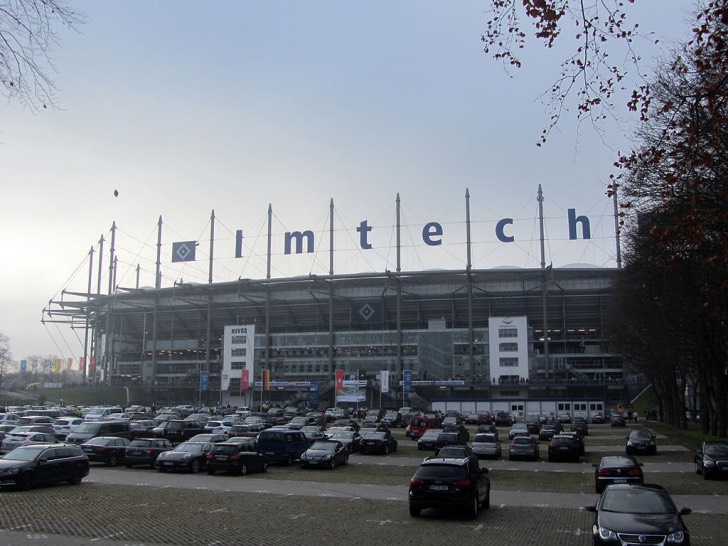
€100 million
Hamburg is a city perhaps best known to English audiences as the place in Germany that The Beatles went to during their more formative years. From a footballing point of view, those who lived through the 1970s and 1980s will remember Hamburger SV well, even if more modern fans wouldn’t think of them as being a German footballing powerhouse. The club had nothing to do with the stadium when it was first built in the 1950s, not moving into it until a decade after it opened. The name translates roughly as ‘The People’s Park Stadium’, which comes from the fact that it’s located in the Altona Volkspark, or ‘People’s Park’.
The ground that exists now is nothing like the one that opened its doors back in 1953, having been completely knocked down and rebuilt in 1998 to assist with Germany’s bid to host the World Cup in 2006. As well as being far more modern and suitable to host big matches than the venue that was originally built, the 1998 renovation included rotating the entire ground ninety degrees in order to take advantage of natural sunlight. It’s a UEFA Elite stadium and has a history of being used for big tournaments. As well as hosting games in both the 1974 and 2006 World Cup and the 1988 Euros, the Volksparkstadion was where the final of 2010 Europa League final between Atlético Madrid and Fulham took place.
Merkur Spiel-Arena – Düsseldorf
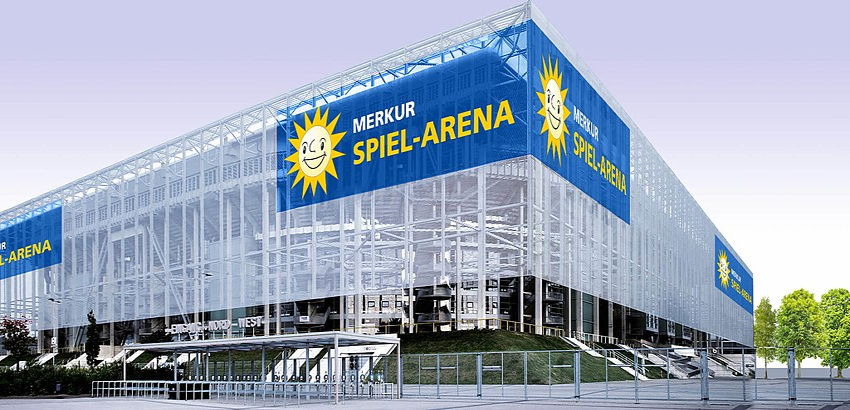
€240 million
Previously known as the Esprit Arena and LTU Arena because of sponsorship deals, the Merkur Spiel-Arena first opened its doors in 2004. It was built on the site of the former Rheinstadion in Düsseldorf and is the home of Fortuna Düsseldorf. Bayer Leverkusen played here for the 2008-2009 season and the German national side also plays some games it every so often. Interestingly, despite being one of the newest grounds in the country at the time, the venue was not used to host matches when Germany was the host nation for the 2006 World Cup. Perhaps even more intriguing is the fact that it has also been used to host matches for the Portugal international team; namely a 3-0 win against Saudi Arabia and a 2-1 defeat to Greece in 2006 and 2008 respectively.
Though it is best-known for its hosting of football matches, the arena has seen numerous different events take place within its walls and therefore knows how to cope with vast numbers of people swarming towards it. For a time it was the home of the NFL Europe side Rhein Fire, for example, resulting in it being the venue for the final of World Bowl XIII and XIV. In 2015 it hosted the boxing match between Wladimir Klitschko and Tyson Fury, which the latter won on a unanimous points decision. It has also been used over the years to host music concerts and the likes of Phil Collins, The Rolling Stones and Bon Jovi have all performed in it. It boasts both a retractable roof and a heating system that ensure it’s comfortable for use in the summer. As with so many other venues in Germany, it has different capacities depending on whether or not supporters are allowed to stand.
MÜNGERSDORFER STADION (RheinEnergieStadion) – Cologne
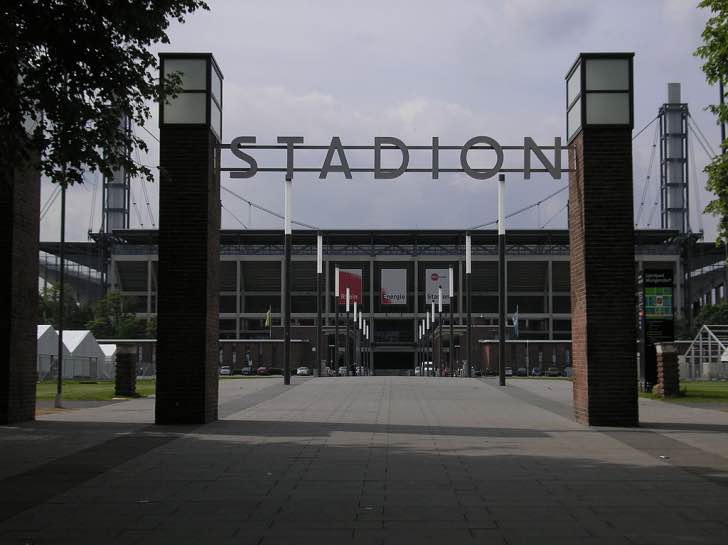
47.4 million DEM
Officially known as the RheinEnergieStadion because of a deal with a local energy supplier, the stadium is built on the site of two previous football grounds that were both known as Müngersdorfer Stadion. Believe it or not, the stadium actually owes its existence in a roundabout kind of way to the Treaty of Versailles, which saw the fortifications that surrounded the city of Cologne removed. That meant that there was then enough room to build a new structure that could be used for entertainment, with the result being the original Müngersdorfer Stadion. Football suddenly became big business in the area and huge crowds went to watch Germany play against the Netherlands in 1927.
In terms of knowing what it takes to host big matches in the most important competitions, the RheinEnergieStadion was used to host games in both the 2005 FIFA Confederations Cup and the World Cup the following year, being one of only five locations to be involved with both tournaments. It’s also the home of the local side 1. FC Köln, accepting thousands of people through its doors on a regular basis during the domestic German football season. The original idea behind the renovation of the ground in the 1970s was to see it become a host venue for the World Cup in 1974, but the cost of renovation kept spiralling and in the end the work couldn’t be completed. As with many other grounds, the capacity depends on whether standing is allowed.
RED BULL ARENA – Leipzig
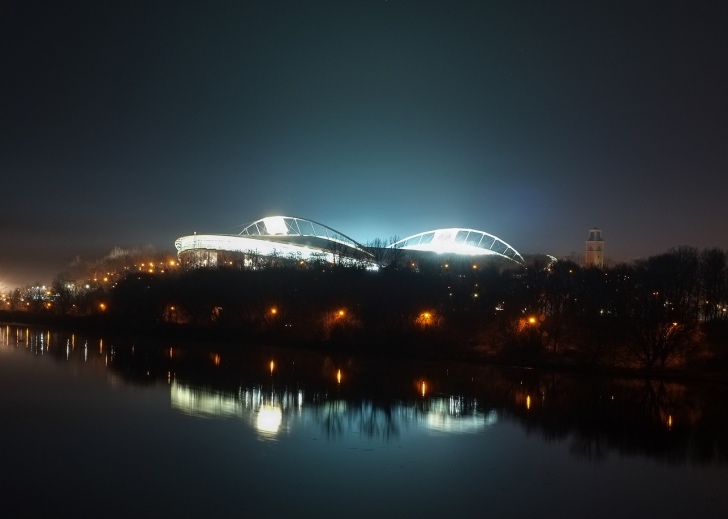
€90 million
Nowhere quite sums up the confusion surrounding sponsorship deals in Germany quite like Red Bull Arena in Leipzig. It’s the home of RB Leipzig, which officially stands for RasenBallsport Leipzig but is shortened to RB because teams themselves are not allowed to bear sponsorship names in German domestic football. The club was only formed in 2009, owned and operated by the soft drink company Red Bull. After they formed the club the drinks maker decided to pump a decent amount of money in the renovations of a stadium that had first opened its doors back in 1956. The result was a brand new stadium being built inside the old stadium between 2000 and 2004.
The newly created venue was used to host matches in both the 2005 FIFA Confederations Cup and the World Cup in 2006, being the only venue from the former East Germany used in the latter competition. When it used for Champions League matches and the like it can revert to its former name of the Zentralstadion, though more often than not it takes on the far simpler moniker of RB Arena. As with many football grounds around the world, Red Bull Arena is often used for music concerts and artists such as Bruce Springsteen, Paul McCartney and Tina Turner have played gigs in it.
Waldstadion (Deutsche Bank Park) – Frankfurt
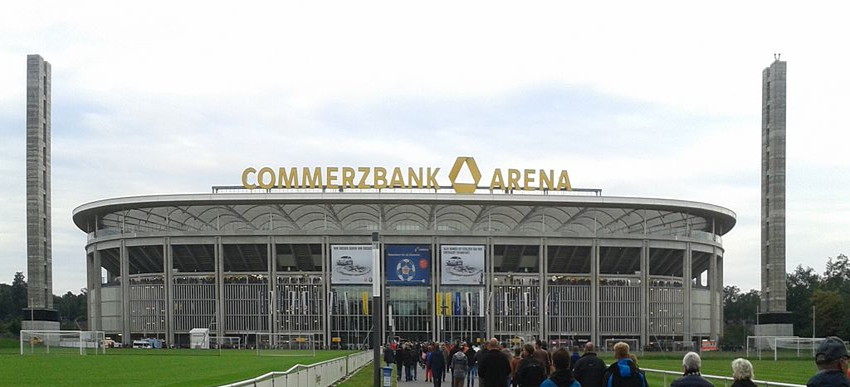
€150 million
Eintracht Frankfurt
The final stadium on the list of host venues for the 2024 edition of the European Championships is the Waldstadion in Frankfurt. The home of Eintracht Frankfurt is occasionally used to host Germany’s international matches, with the national side having no one specific location. It first opened its doors in 1925 and, as with so many other venues around the country, has been renovated so many times over the years as to be virtually unrecognisable from that original ground. Renovations have occurred in 1937, 1953, 1974 and 2005, meaning that the true cost of the ground isn’t really known.
The first renovations occurred after more supporters got into the ground than it was intended to host, leading to two hundred people being injured. More renovations took place ahead of it being used as a host venue for the World Cup in 1974, whilst the ground as it currently is was built in 2005 and then used for the opening match and the final of that year’s Confederations Cup. That was a precursor to the World Cup the following year, so it’s fair to say that the Waldstadion knows what’s involved in the hosting of major tournament matches. It is located within a sports complex in the city of Frankfurt, with venues for the likes of tennis and beach volleyball also being located nearby.
How To Get To Euro 2024 in Germany
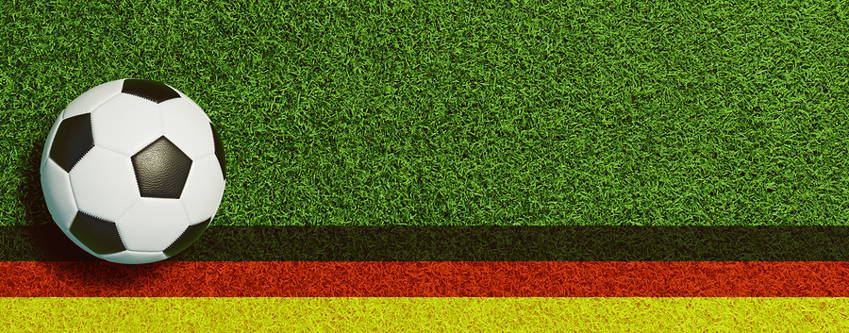
As a major country in the heart of the European Union, Germany is significantly easier to get to than other host nations might be. The obvious comparison is to the country being used for the World Cup four years before, Qatar, which simply doesn’t have the infrastructure to easily cope with neither the arrival nor the movement of hundreds of thousands of football supporters. Germany, on the other hand, is well-serviced by any number of methods that fans might wish to use to travel to the country.
The most obvious method of travel that most will plump for is plane and the country is well-stocked for airports. Indeed, the major cities often have not one but two different airports that you’ll be able to arrive at. Within the country itself there is both a decent train network and also exceptional travel methods for those of you wishing to drive; the autobahns are the envy of most of Europe. Depending on how you hope to arrive, you’ll be able to travel either via the EuroTunnel or ferries before making your onward journey. In short, Germany is one of the best connected countries in the world and your travel during the World Cup should be relatively stress-free.
Tournament Format
Previous Qualification Formats
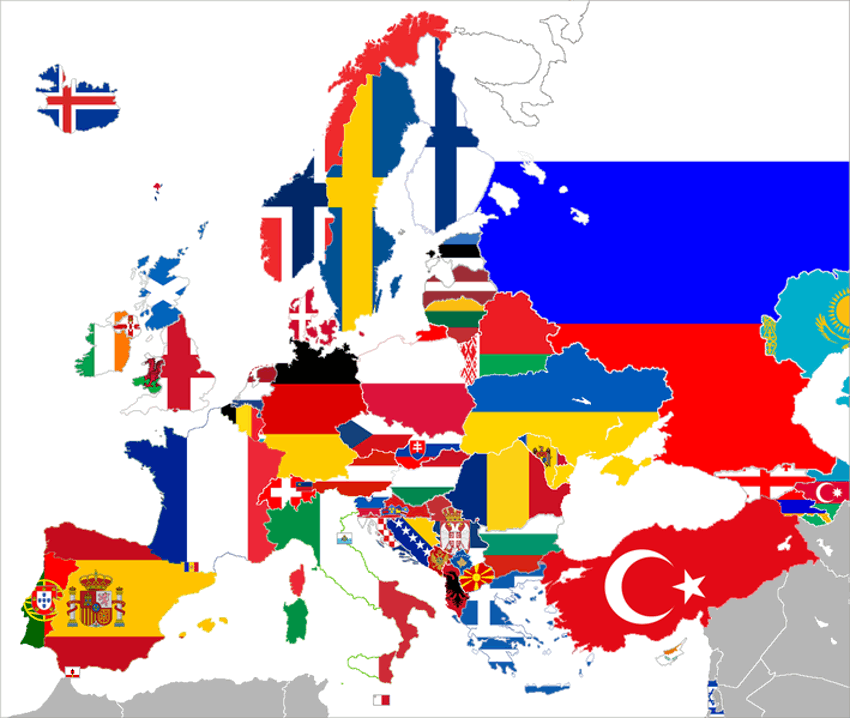
The initial tournament from 1958 to 1960 involved 17 teams that subsequently went through a knockout to find four teams that then competed in the finals. Back then the country that would host the finals had to be one of the 4 qualifiers, for the initial championships Paris was selected. For the 1964 tournament in Spain the number of entrants increased to 29 but the format of having a knockout followed by 4 finalists remained. In 1968 a group stage was introduced for qualification, there were 8 groups of 4 and the winner of each group would progress to a quarter final, the 4 winners of the quarters would progress to the finals. This format continued until 1980 when the competition was expanded to include 8 teams in the finals.
From 1980 onwards the country that would host the finals was decided in advance with the host country given a bye to the finals. The groups were reduced to seven in order that 7 group winners could progress alongside the host nation.
The tournament expanded to 16 teams in 1996, this was also first and only European Championships hosted in England. This was also the first year that the term ‘Euro’ was used. Groups were again increased to 8 with the 8 winners and 6 highest runners up qualifying for the finals and the two worst runner up competing in a playoff to make up the final place.
Since 1996 the format has changed for each subsequent championship. In 2000 the number of groups increased to 9, the winners automatically qualified along with the best second placed team. The remaining 8 teams competed in a playoff to make up the final 4 places (plus two hosts Belgium and Holland). Qualification for the 2004 tournament saw the winners of 10 qualification groups with all second place teams competing in a playoff for the remaining 5 places. In 2008 this switched back to 7 groups with the top two teams in each qualifying along with the two hosts. Then in 2012 the system switched back to a similar style to 2000 with 9 groups, 9 winners, the bet runner up and a playoff between the remaining 8.
Euro 2016 was the first tournament to be held since the decision to expand to 24 teams after 51 UEFA members voted in Michael Platini’s new structure. The hosts (France) qualified automatically with the remaining 23 places made up from the winners and runners up from 9 groups, the best third placed team and with the remaining 8 third placed teams competing in a playoff for the remaining 4 places.
As Euro 2020 was a pan-European tournament there was no automatic place given to a host, therefore all 24 teams qualified through the groups and the Nations League. There were 10 qualification groups for Euro 2020 with both winners and runners up qualifying automatically. The remaining 4 places were then allocated to the UEFA Nations League. Each league (A, B, C and D) was given one place, the highest four teams in each division (that haven’t already qualified through the groups) then competed in a play off system for the remaining 4 places. Over-complicated, perhaps?
With Euro 2024 reverting to a single host it means Germany will automatically qualify. It is likely that 20 places will again be available through qualification groups with 3 places awarded to the Nations League.
European Championship Finals Format
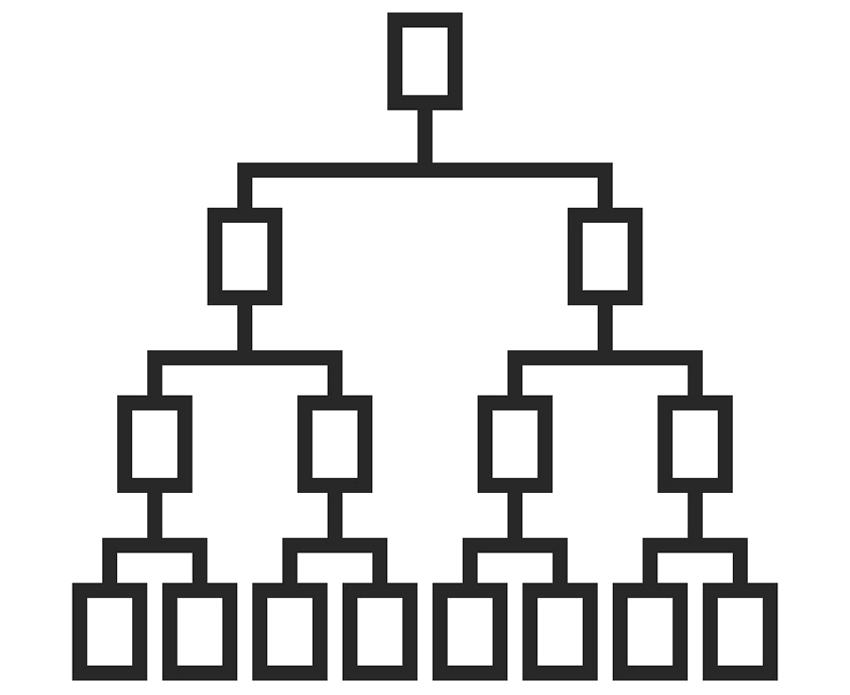
The European Championship Finals was initially a simple knock out system where the 4 finalists competed in a semi-final and then a final. In 1980 when the number of finalists was doubled to 8 a group stage was added. Two groups of 4 competed, the winners went on to contest the final and the runners up played for third place.
In 1984 the format changed with the top two in each group competing in a semi-final and the third place playoff abolished.
In 1996 the number of groups increased to 4 to accommodate the now 16 finalists.
The top two from each group progressing to a quarter final stage. This system remained in place until Euro 2016 where the addition of a further 8 teams has allowed for a round of 16 for the first time. The top two in each of now 6 groups progress directly. The remaining 4 places are made up of the four highest 3rd place finishers. The competition then progresses as a normal knockout tournament until the final.
Euro 2024 Format

In 2024 the Euros will revert back to a single country, this was awarded to Germany in 2018. This means there will only be 23 places to qualify for with Germany themselves qualifying automatically a host nation.
The qualification format is yet to be fully formalised but will likely be similar to the 2021 event, with most places coming winners and runners-up from mini-qualification groups, and the rest coming from the UEFA Nations League (if it in fact survives that long!).
For more about the tournament in Germany and details about the venues that will be used see our Euro 2024 stadiums guide.
Extra Time, Penalties and Golden Goals
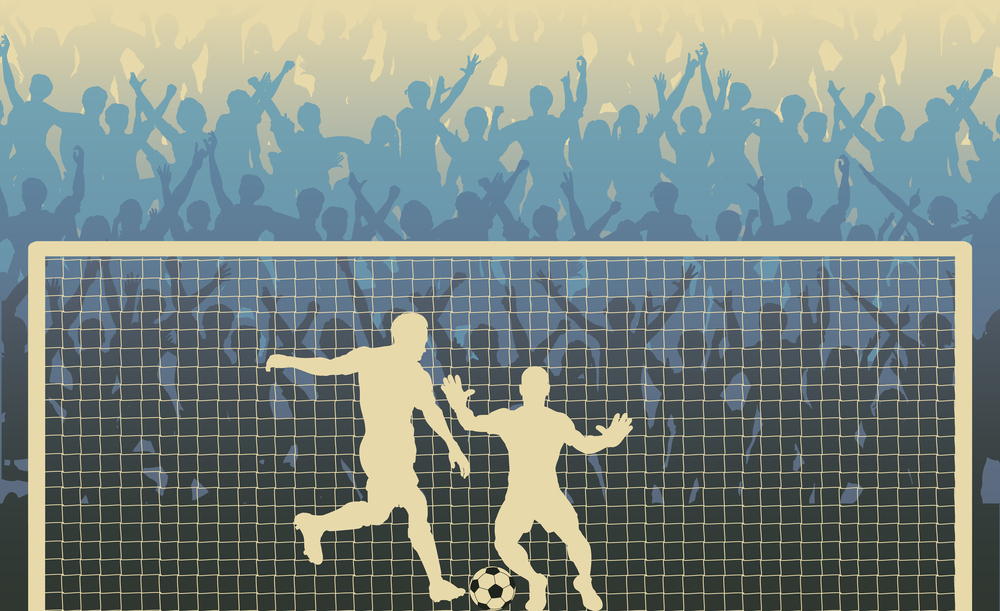
Prior to 1976 if the game was a draw after extra time the match went to a replay. This happened once in 1968, following a 1-1 draw Italy beat Yugoslavia 2-0 in the replay. The first penalty shoot out in a Euro final saw Czechoslovakia beat West Germany 5-3 following a 2-2 draw in Yugoslavia. From 1976 until 1992 this format remained unchanged until one day someone in UEFA (probably someone who knows nothing about football) decided to create the golden goal system for the 1996 European Championships in England. Germany won Euro 1996 2-1 with a golden goal in extra time, a golden goal means the match simply stops with a winner immediately declared, with the remainder of extra time is forfeited.
For the 2004 tournament the golden goal was replaced by the silver goal. This meant if there was a goal in the first half of extra time the match would still continue but only until half time of extra time. If there was a goal in the second half of extra time then the game continued to the end as normal. Greece knocked out the Czech Republic on the way to the 2004 final through this method.
In a victory for football fans everywhere after some considerable pressure from supporters, FIFA and UEFA decided to remove both golden and silver goals after the 2004 championships. From now on if you team goes to extra time they play the full half hour, if a result is still not reached the game goes to penalties.
Previous Winners
| Year | Host | Final | Result | Stadium | ||
|---|---|---|---|---|---|---|
| 2024 | Germany |  | v |  | ? | Allianz Arena |
| 2020 (2021) | Pan Europe |  Italy Italy | v |  England England | 1-1 AET 3-2 PS | Wembley |
| 2016 | France |  Portugal Portugal | v |  France France | 1-0 AET | Stade De France |
| 2012 | Poland & Ukraine |  Spain Spain | v |  Italy Italy | 4-0 | Olimpiyskiy National |
| 2008 | Austria & Switzerland |  Spain Spain | v |  Germany Germany | 1-0 | Ernst-Happel-Stadion |
| 2004 | Portugal |  Greece Greece | v |  Portugal Portugal | 1-0 | Estádio da Luz |
| 2000 | Belgium & Holland |  France France | v |  Italy Italy | 2-1 AET | Feijenoord Stadion |
| 1996 | England |  Germany Germany | v |  Czech R Czech R | 2-1 AET | Wembley |
| 1992 | Sweden |  Denmark Denmark | v |  Germany Germany | 2-0 | Ullevi |
| 1988 | W. Germany |  Holland Holland | v |  USSR USSR | 2-0 | Olympiastadion |
| 1984 | France |  France France | v |  Spain Spain | 2-0 | Parc des Princes |
| 1980 | Italy |  Germany Germany | v |  Belgium Belgium | 2-1 | Stadio Olimpico |
| 1976 | Yugoslavia |  Czech Czech | v |  Germany Germany | 2-2 AET 5-3 PS | Stadion FK Crvena Zvezda |
| 1972 | Belgium |  Germany Germany | v |  USSR USSR | 3-0 | Heysel Stadium |
| 1968 | Italy |  Italy Italy | v |  Y'slavia Y'slavia | 1-1 (2-0 Replay) | Stadio Olimpico |
| 1964 | Spain |  Spain Spain | v |  USSR USSR | 2-1 | Bernabéu |
| 1960 | France |  USSR USSR | v |  Y'slavia Y'slavia | 2-1 AET | Parc des Princes |
KEY: AET - After Extra Time, PS - Penalty Shoot Out, R - Replay
Home Nation Results
Finals
| Country | Apps | Games | Wins | Draws | Loses | Highest | Goals F | Goals A | Hosted |
|---|---|---|---|---|---|---|---|---|---|
 England England | 10 | 38 | 15 | 13 | 10 | Final (Runner-Up) | 51 | 37 | 2 |
 Wales Wales | 2 | 10 | 5 | 1 | 4 | Semi-Final | 13 | 12 | 0 |
 Scotland Scotland | 3 | 9 | 2 | 2 | 5 | Round 1 / Group | 4 | 5 | 0 |
 N. Ireland N. Ireland | 1 | 4 | 1 | 0 | 3 | Last 16 | 2 | 3 | 0 |
Qualification
| Country | Apps | Games | Wins | Draws | Loses | Qualifications | F | A | Rank |
|---|---|---|---|---|---|---|---|---|---|
 England England | 14 | 108 | 73 | 24 | 11 | 9# | 258 | 64 | 7th |
 Wales Wales | 15 | 112 | 45 | 23 | 44 | 2 | 131 | 139 | 25th |
 Scotland Scotland | 14 | 122 | 57 | 28 | 37 | 3 | 183 | 139 | 17th |
 N. Ireland N. Ireland | 15 | 120 | 44 | 27 | 49 | 1 | 131 | 154 | 24th |
# England have qualified for 9 tournaments but appeared in 10 thanks to automatic qualification as hosts in 1996.
European Championship Stats
European Championships key facts, trivia, records and statistics.
| Tournament Stats | |
|---|---|
| Most Goals | 142 (2020) |
| Least Goals | 7 (1968) |
| Most Individual Scorers | 80 (2020) |
| Most Goals/Game | 4.75 (1976) |
| Least Goals/Game | 1.4 (1968) |
| Highest Attendance | 79,115 (Bernabeu - USSR v Spain 1964) |
| Lowest Attendance | 3,869 (Nou Camo, Hungary v Denmark 1964) |
| Attendance Total | 2,427,303 (2016) |
| Team / Country Stats | |
|---|---|
| Most Championships | Germany, Spain (3), France (2) |
| Finals | Germany (6), USSR (4) |
| Runners Up | Germany (3), USSR (3) |
| Semi-Finalists | Germany (9), Russia (6) |
| Most Hosted | France (3) |
| Most Appearances | Germany (13) |
| Consecutive Winners | Spain (2008 – 2012) |
| Most Matches | Germany (53) |
| Most Wins | Germany (27) |
| Most Loses | Denmark (17) |
| Most Draws | Italy (18) |
| Goals Scored | Germany (78) |
| Goals Conceded | Germany (55) |
| Highest Goal Ave | Netherlands (1.67/game) |
| Lowest Goal Ave | Norway (0.33/game) |
| Consecutive Qualifications | Germany (13) |
| Penalty Shoot Outs | Italy (6) |
| Player Stats | |
|---|---|
| Top Scorer (Single Finals) | Michel Platini (9 – 1984) |
| Top Scorer (All Finals) | Christiano Ronaldo (14) |
| Top Scorer (Qualification) | Christiano Ronaldo (31) |
| Top Scorer (Total) | Christiano Ronaldo (45) |
| Fastest Goal | Dmitri Kirichenko (68 seconds 2004) |
| Most Medals | Rainer Bonhof (3 – Germany) |
| Most Appearances (Finals) | Christiano Ronaldo (25 - 2153 minutes) |
| Youngest | Kacper Kozłowski (17yrs 246days) |
| Oldest | Gábor Király (40yrs 74days) |
About the European Championship
The European Nations Cup
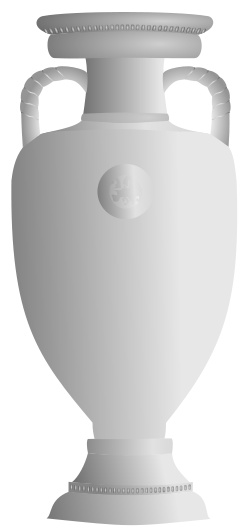
The European Championships was a late comer to the party with other continental competitions in full swing well before the Euros.
It is often cited that the devastating effect of the second world war in Europe was the principle reason for a lack of appetite in the 15 years following the declaration of peace in 1945.
If anyone was ever going to propose an inclusive European tournament it had to be the French.
In 1927 the French Football Federation secretary general, Henri Delaunay, proposed the initial idea for a Europe-wide football tournament.
In conjunction with Hugo Meisl he submitted plans to FIFA for a tournament to run concurrently with the World Cup.
Unfortunately, due to political tensions, it took until 1958, three years after Delaunay died, for the idea to come about. The trophy was subsequently named after Delaunay’s in his honour.
It was in fact the French newspaper L’Equipe that re-proposed the idea in 1954 and with support form Henri Delaunay’s grandson, Pierre, a drive towards a European Nations Cup was created.
Pierre became secretary to the organising committee for the competition in 1955 and later that year the European Nations Cup format was agreed.
1960 – The First European Championship
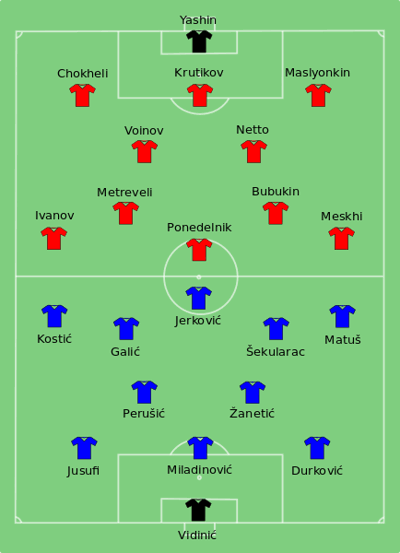
The first European Nations Cup saw 17 members (around half of the total members) join in 1958. Notably England, Italy, Holland and West Germany did not compete.
The first ever match to take place under the umbrella of the new tournament was a playoff match between the Republic of Ireland and Czechoslovakia who were drawn through lots, Czechoslovakia won.
The first match proper took place between the Soviet Union and Hungary, the USSR winning 3-1. Over 100,000 people turned out for the game that saw Anatoli Ilyin become the first ever scorer in the completion in the Tsentralni Lenin Stadium in Moscow. The Soviet Union won the second leg 1-0 to progress.
The first competition took place over 22 months from 1958 to 1960 with the 16 teams competing in knock out matches. Following their initial victory over Hungary the Soviet Union team were refused access to Spain by the dictator General Franco, this gave them a bye directly to the finals. The remaining 4 teams left were France, Soviet Union, Yugoslavia and Czechoslovakia. France was selected as the initial hosts, probably due to the huge role the French had played in creating the competition in the first place.
France were eliminated by Yugoslavia 5-4 and to this day this remains the highest scoring game in the championships. Yugoslavia played the USSR in the final in Paris on July 10th 1960, despite being dominated for most of the game it was the USSR that came out victors winning 2-1 after extra time.
1960 to 1980
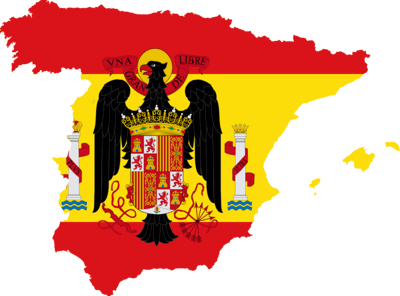
In 1964 from the four remaining finalists Spain were selected by the hosts. They played the 1960 winners, the Soviet Union, winning 2-1 with Hungary and Denmark competing for third place.
In 1968 he tournament was again won by the hosts, Italy, who beat Yugoslavia on a reply. The match was a 1-1 draw after 90 minutes and prior to the advent penalties it was forced to a second game that the Italians won 2-0.
Belgium hosted in 1972 with West Germany coming out as victors in 3-0 win over the Soviet Union at Heysel in Brussels, pretty much the same German team that win the world cup two years later in 1974.
The last competition in which only four teams competed took place in Yugoslavia in 1976, this was also the last tournament until 2020 where the hosts were required to qualify.
Czechoslovakia this time beat West Germany in the newly designed penalty shootout, the game was 2-2 after extra time with the Czech’s winning 5-3 on pens.
1980-1996
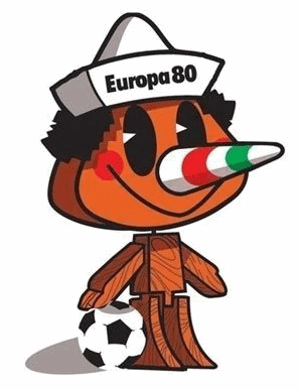
For the first time the host, Italy, was pre-selected and did not have to qualify. West Germany won their second title beating Belgium in the final in the Stadio Olympico in Rome 2-1.
France were hosts in 1984 and won the tournament for a second time, Michael Platini, later UEFA president, scored 9 goals in 5 games, this included the first goal in the final as France beat Spain 2-0.
The Netherlands won the 1988 competition beating hosts West Germany in the semi-finals and the USSR in the final 2-0.
1992 was the last competition with 8 teams. Yugoslavia could not compete despite qualiftying due to the ongoing war in the region. Denmark took the place of Yugoslavia in the tournament hosted by Sweden.
The Danes won the competition beating the current holders, the Netherlands, in the semi-finals and the newly unified Germany in the final 2-0.
1996-2012
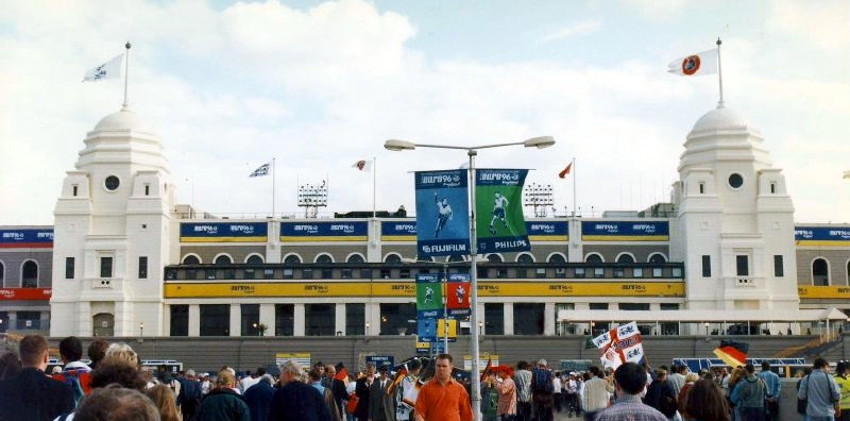
The 1996 European Championships were hosted by England with the finals expanded to 16 teams, it was also the first time the term Euro was used to describe the tournament. Now the winners and runners up from 4 groups moved to a quarter final knockout stage. This format remained in place up to an including 2012.
England were knocked out in the semi-finals by Germany on penalties in the semi-finals, the Germans went on to beat the Czech Republic in the final 2-1 winning the trophy for a third time. This was also the first occasion in which the golden goal was used to decide the winner.
Euro 2000 was the first to be hosted by two countries, Belgium and the Netherlands. The then world cup holders France went on to win beating Italy in a heated final 2-1. Euro 2004 saw one of the biggest upsets yet when Greece beat the hosts Portugal 1-0 in the final. They were 150/1 before the start of the championships.
Euro 2008 and Euro 2012 were again co-hosted by Austria and Switzerland and Poland and Ukraine respectively. The 2008 final was won by Spain who outclassed all opponents along the way beating Germany 1-0. The 2012 final was again won by Spain who beat Italy 4-0. Spain also won the World Cup in the intervening years to become the only team defend a European title and also the only team to win three international major tournaments back to back.
Euro 2016
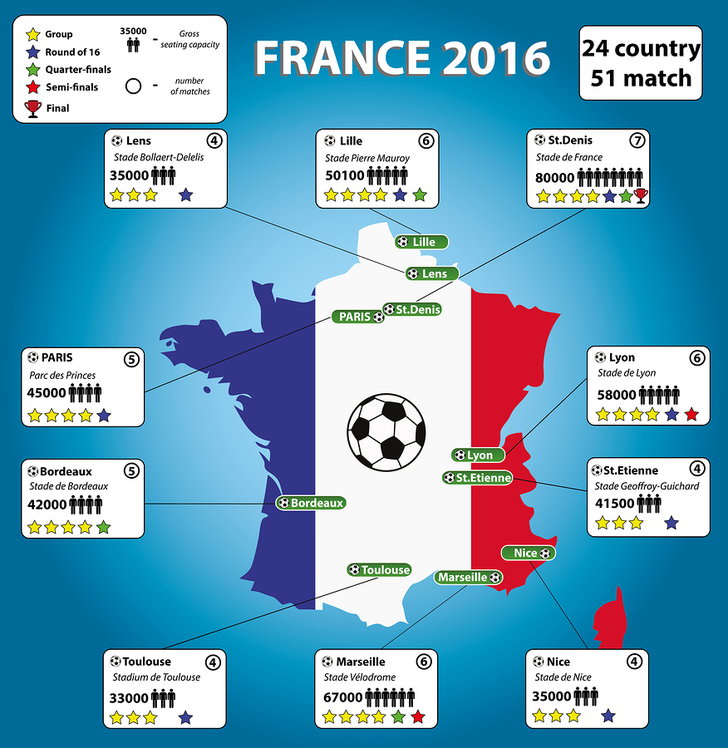
The last incarnation of the European Championships saw the number of finalists increase to 24 with the addition of a new round of 16 at the knock-out stage.
The finals were held in France for the third time although this could be the last finals to be hosted by a single nation as Euro 2021 will be held across several European cities.
Tournament favourites and largely the best team France were beaten in the final 1-0 after extra time by Portugal, the Portuguese only managed one win in 90 minutes in the entire tournament.
Despite finishing third in their group with three draws, the easiest group as well, Portugal went on to win the tournament for the first time in their history.
The final in 2016 was a perfect contrast to the 2004 final where it was Portugal, the tournaments best team, who were beaten by a dogged and resistant Greece side. Euro 2016 stadium guides, statistics and fixtures can be found in our Euro 2016 archive.
Euro 2020 (2021)
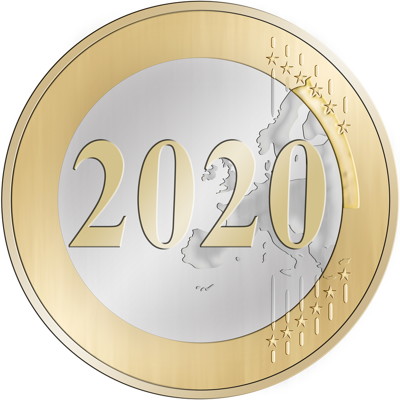
Euro 2020 will always have an asterisk next to it thanks to the fact it is called Euro 2020 but was held in 2021. The tournament was delayed by a year due to the outbreak of coronavirus that spread through Europe in 2020, the tournament was not, however, renamed as UEFA and the sponsors had already done the branding and made all the merchandise.
Whatever you call it it will be remembered because it was different, played in front of reduced crowds with travel restrictions in place for many fans. It will not live long in the memory just because it was delayed either, it was also the first tournament to have no fixed host, instead played in 11 different cities across the continent. In fact, it should have been 12 cities by Dublin had to withdraw due to restrictions in place at the time due to coronavirus.
Euro 2020 produced some really high quality football matches, much better than seen 5 years previously. This was evident by the fact that 142 goals were scored compared to 108 in 2016, there were also far fewer booking and refereeing was much better allowing free flowing games. Even VAR was good with a largely light touch approach that actually enhanced decision making for a change.
England went into the tournament as favourites and lived up to the billing by making it all the way to the final, although they did have a relatively easy run through and huge home advantage thanks to the fact 6 out of 7 of their matches were played at Wembley, including the final. It was Italy who went home with their second title though, beating England on penalties (predictably) following a 1-1 draw in normal time. Christiano Ronaldo was the golden boot winner with 5 goals, despite Portugal only making it to the last 16. He also became the record all time goalscorer with a record number of appearances.
Euro 2020 stadium guides, statistics and fixtures can be found in our Euro 2020 archive
Previous Tournaments
Euro 2020 Stadiums
Despite being cancelled in 2020 due to coronavirus and moved to 2021 the tournament retained the name Euro 2020 due to branding. It was played across Europe in 11 different stadiums in 11 different cities. England an Italy reached the final and England yet again went away disappointed losing in a penalty shoot out. The tournament will mostly be remembered, though, for producing high quality football, lots of goals and with a very good standard of refereeing.
Euro 2016 Stadiums
Euro 2016 wasn’t the greatest championship by a long way for the football quality but it did smash the overall attendance record with just under 2.5 million people watching the 51 matches. The 2016 championship was the best yet for atmosphere and this owes a great deal to the ten great stadiums used to host the championships. Visit our Euro 2016 stadiums for a full list ofground guides and all the fixtures.
